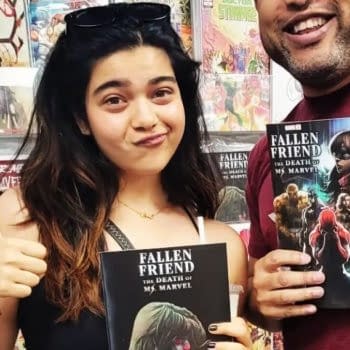Posted in: Comics, Recent Updates | Tagged: adam hughes, Christina Blanch, Comics, Dave Gibbons, entertainment, gail simone, Marguerite Bennett, Paul Levitz, Thom Zahler
Sexy Or Sexualized? The Depiction Of Women In Comics With Paul Levitz, Gail Simone, Dave Gibbons, Marguerite Bennett, Adam Hughes, Christina Blanch, And Thom Zahler At Baltimore Comic Con
Paul Levitz moderated a panel on the depiction of women in comics at Baltimore Comic Con this year on Friday with panelists Gail Simone, Dave Gibbons, Marguerite Bennett, Adam Hughes, Christina Blanch, and Thom Zahler.
Levitz opened by pointing out that whether a character is depicted as sexy or sexualized in comics is a very old argument, and often descends into the subjective. He read a quote from Amy Reeder (Rocket Girl) about trying to "pinpoint" the line when things are one or the other. Reeder has settled on the word "personhood", and asking whether a character is treated as an object or a full individual through their depiction. Levitz promoted the need for an "aesthetic answer" to try to make progress on this distinction.
Gail Simone insisted she didn't need the mic, and mentioning Secret 6, and the idea that this comic has everything in it that Wertham didn't want. Simone, who likes "cheesecake art", says trying to decide whether everyone has the same sensibility merely needs a browse through Tumblr to show the range of distinctions. Simone spoke about having both "beautiful female characters" and stories in cover art, even, with the story balancing the presentation. Is this "dishonest"? She asked, or does it serve a purpose?
Dave Gibbons claimed he doesn't know why he was placed on the panel, laughing, and related growing up in the UK having separate boys and girls comics with rare gender crossover. He grew up drawing stories featuring whoever was in the writing, but when he came to drawing girls or women later in life, he simply drew them as characters, and doesn't consider "sexy women" to be his artistic forte. When he thinks of the most famous characters he's drawn, he thinks of Martha Washington, who just has "human" attributes. He admits a degree of "deliberate Cheesecake" in Watchmen, in homage and critique of older comics, but he hasn't specifically aspired to do that otherwise.
Marguerite Bennett said that for her a lot of it comes down to "personhood and power", and when artists depict a character in a certain way, they should ask whether this is "authentic" to character, inviting a "gaze" or "deflecting" gaze. When coming up with a "sexy superhero" female, people tend to argue that the character is sexual in personality and wants to be looked at. That argument breaks down when you note that "almost all of them seem to be this way". Presenting the character as a "real person" is her biggest concern when designing characters and costumes. On Tumblr she's recently seen Roman classical statue images with photo-shopped with iphones and such. Adding the iphone becomes an "indictment of vanity", looking at herself as beautiful in the case of female statues, whereas without the phone, it was somehow "ok" for her to be looked at by others as beautiful.
Adam Hughes was specifically asked bout his cover work. He said that he primarily goes on "instinct". But working on Penthouse Magazine in the past did change his "barometer" so that he is often asked to "dial" things back a little. He cited a cover where he had one character "licking" another and thought it was funny whereas others thought he was crossing the line. Simone intervened on the project and asked what would happen if sexual roles were reversed on the cover, and then the cover was immediately accepted. He's asked himself in the past, "Does this look good? Does this tell a story". He admits that he's at an age where things that were commonplace as a child have, in recent years, become more taboo and the language instilled into him by society has now changed. He now has to predict how things could possibly be "misinterpreted", he said. A female audience member explained saying "welcome to being a woman" in the fear of being "misinterpreted", whether in clothing, how one looks, even how one smells. Her statement got a round of applause.
Christina Blanch comes at this question as an educator and also as a comics creator. She commented that she was brought up without really being "told" she was a girl and traditionally wanted to be Han Solo growing up. There are things that are sexualized, and some that are sexy, but it's in fact "everywhere", she said. She has similar reactions to many others she knows to comics images. She had no problem with the Power Puff Girls cover, for instance. It's like looking at clouds, she said, where people see different images and sees things differently based on their experiences. When she's writing, she feels she can "get away" with more than a man might because she is a woman.
Thom Zahler said there's a degree of "cognitive dissonance" when you have characters depicted in a certain way, and then they are printed on underoos. It's not appropriate to have the same degree of sexuality for different age groups, he suggested. He presented the example of PG-13 superhero movies and how many parents take young children to see them when there is a degree with sexuality.
Blanch added that the character Starfire, who was liked by children, and then when represented in recent years, parents were hoping they wouldn't be interested in her anymore. Working on a comic shop, she's seen children reaching for the much "sexier" Starfire.
Levitz pointed out that there are thousands of pages of comics produced with only a certain degree of controversies, and that's something to keep in mind. Blanch pointed out that her 14 year old daughter likes Hughes' Bombshell covers, for instance, and the panelists batted back and forth how much to keep from children in an over-protective way.
Gibbons spoke about the sexualized presentation of male heroes also, suggests a certain degree of "laziness" in the artist, and Simone chimed in, to applause, that the problem of only presenting a very narrow degree of body types is massive. She added, humorously, that sometimes as a writer, she describes a scene, and seeing it come back from the artist looking inappropriate was an issue based on her inadvertent description.
Karen Green, Graphic Novels librarian at Columbia University, asked from the audience why the conversation derailed into age appropriateness when the problem is bigger regardless of age group. "We all know the Milo Manara cover is inappropriate for a 12 year old, but isn't it also inappropriate for a 42 year old?", she asked. Is this the image we want to project in comics?
Responding to Dave Gibbons about the sexualization of male characters, she pointed out that men are idealized athletically rather than sexually, and the equivalent of sexualizing a male hero to the extent of the way in which female characters are sexualized would be to give male heroes a "huge package".
Simone commented that it's a "cultural thing" that's pervasive, where photos-shopping is used even on comic covers to make them sexier. Blanch agreed, and cited sending students out to find any ad and notice how it's sexualized, things in society that are simply accepted. Things are "photo-shopped everywhere", not just in the comics industry, Levitz agreed, "But we're here in the comics industry and we're trying to change it".
Simone said that we have to sit down and admit that comic readers are diverse now, and stop tailoring the comics to suit only a tiny group of readers who expect a certain kind or degree of sexiness. Gibbons and Simone discussed "just creating characters" versus a male or female character with sexuality. Simone wants things that are "new" in comics, "compelling and three dimensional". Blanch added, "And create good characters. Not all women act the same way. I don't know if you've noticed…" to laughter. Zahler talked about the need for characters to wear "practical, real clothes" in his stories, and for characters to dress differently based on their personalities.
An audience member talked about Kelly Sue DeConnick's "Sexy Lamp" test, wherein if a character can be replaced by a "sexy lamp", they are not being created as "real characters". Gibbons said that he deliberately drew different body types in Watchmen, exploring the "nuances" of characters rather than primary characters. Then it becomes "much more art" for Gibbons.
Levitz reminded that a comic writer should be creating characters who can't be "substituted" for each other, especially when describing them the artist. He needs to give artists "different cues" to do that. "Nobody should be substitutable for anyone else", he said in a heartfelt way, and that character should be as unique as "everyone in this room".
On this note, Simone responded to a question from the audience about clothing and being sexy without sexualizing, and said that she has no problem with using Red Sonja's "trademark" chainmail bikini given that she wears other types of clothing too and it is much more uncomfortable, as a character, to wear a formal dress. But she doesn't take up "penthouse poses" in the comic because it doesn't fit with her character.
Bennet cited examples that "feel authentic" and make characters "a person", and that's what makes them "ok".
Levitz summed things up as a "continuing discussion" as all important things are.


















